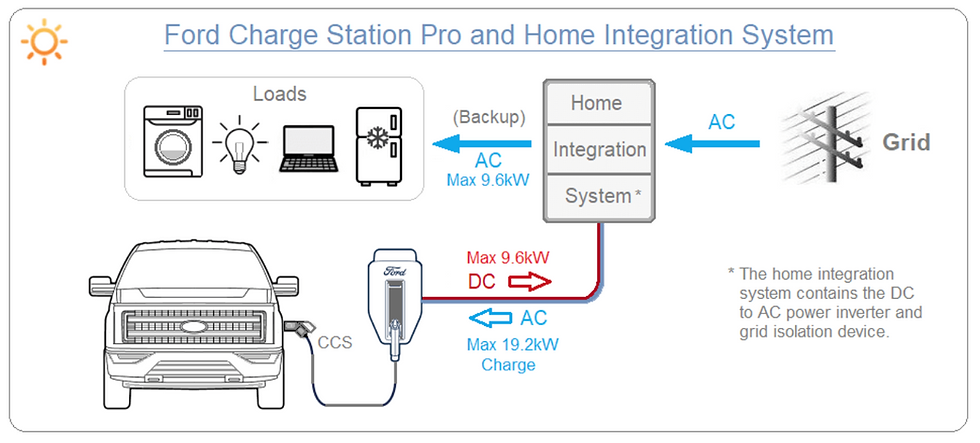
Key Points
Ford has introduced bi-directional charging technology on the F-150 lighting
Bi-directional charging will allow electric vehicles to power homes, other EVs, or even tools on a job site
This system consists of an inverter, transfer switch, and battery, and in the US it will be sold through Sunrun
A fully charged EV could support an average home for several days at a time.
The use of bidirectional chargers for Vehicle-to-home or V2H is as the names suggest, V2H enables an EV to be used much like a home battery system to store excess solar energy and power your home. A typical home battery system, such as the Tesla Powerwall, has a capacity of 13.5kWh, while the Ford F-150 lighting largest EV battery has a capacity of 131kWh, which is equivalent to almost 10 Tesla Powerwalls. Due to the large battery capacity, a fully charged EV could support an average home for several days at a time, or much longer when combined with rooftop solar.
So with this latest technology and most exciting feature bidirectional charging, the new US built F-150 Lightning EV allows owners to power their homes in an emergency or power outage. Users will also need Ford’s “Home Integration System,” and it’s reasonably priced.
Bi-directional charging will allow electric vehicles to power homes, other EVs, or even tools on a job site. And while all of that sounds great, it’s the home backup power that has buyers excited.
You’ll need an F-150 Lightning, Ford’s Charge Station Pro announced earlier this year, and the Home Integration System to power your house. Until now, we didn’t know how much that last piece of the puzzle would cost, but now we know it’ll be roughly $3,900US ($5,500AUD).
While the Charge Station Pro home charging solution costs $1,300US ($1,840AUD) from Ford, those who buy the Extended Range F-150 Lightning EV get one for free. As a result, it’ll only cost an additional $3,895US ($5,500AUD) plus installation to make your home compatible with this feature.
Matthew Stover, Ford’s director of Charging and Energy Services, recently confirmed how much this will cost and how potential buyers can get started.

“The Home Integration System is required to truly take advantage of two-way power flow of F-150 Lightning. This system consists of an inverter, transfer switch, and battery, and will be sold through Sunrun. When the power goes out, the system automatically disconnects from the utility line and switches over to Ford Intelligent Backup Power so that the truck can send power to your house.”
Keep in mind that the price doesn’t include installation costs, which can vary depending on your specific home setup. And while that may sound expensive at first glance, many expected Ford’s home power system to cost substantially more.
For example, a home Powerwall costs over $10,000 plus installation in Australia, and you’ll also have to add solar panels to your roof, and it won’t power a home for as long as Ford’s F-150 Lightning.
The main benefit of bidirectional charging is the possibility of ‘energy independence. This means reducing or eliminating your reliance on grid electricity.
Bidirectional charging will unlikely allow you to go completely off-grid, but it will reduce your grid energy use significantly.
Electric vehicles are already changing the way we commute, and now with V2H smart charging, EVs can now change the way we consume electricity too!. Not to forget, these vehicle to grid integrations will challenge traditional businesses of utility companies and require meaningful commitment from car OEMs as well.
One has to say, the EV revolution is delivering more benefits than most would have ever imagined.


Kommentarer